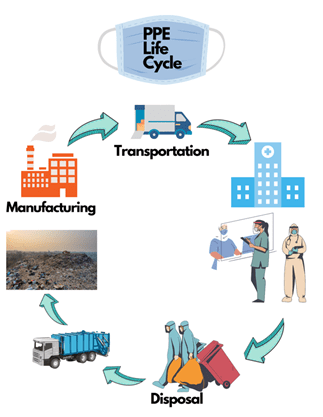The COVID-19 pandemic has brought unprecedented challenges to global health, with Personal Protective Equipment (PPE) becoming a critical safeguard for frontline workers and the general public. However, the increased use of disposable masks, gloves, gowns, and face shields has led to a mounting problem: PPE waste. What was initially a necessary step to protect human health has quickly become a major environmental concern, as billions of pieces of single-use PPE end up in landfills, oceans, and natural habitats.
The sheer scale of PPE waste demands an urgent, coordinated global response. While some countries and organizations have begun to address the issue locally, a broader, international strategy is essential for managing and reducing the environmental impact of this growing problem.
1. The Growing Global PPE Waste Crisis
The pandemic has drastically increased the consumption of PPE across industries, especially healthcare. This staggering amount of waste contributes significantly to pollution, especially because most PPE is made from non-biodegradable materials such as polypropylene and polyethylene. Once used, most of this equipment is discarded and often ends up in landfills, or worse, in our oceans.
The most concerning part is that PPE waste in TN is not only a matter of volume but also of contamination. Masks and gloves, commonly contaminated with bodily fluids or other hazardous materials, cannot simply be recycled without proper sanitation. This complicates the disposal process and leads to greater environmental damage.
Without proper disposal and recycling systems in place, PPE waste is rapidly becoming a critical environmental issue.

2. The Challenges of Managing PPE Waste
a. Lack of Recycling Infrastructure
While many materials used in PPE are technically recyclable, the infrastructure for recycling used PPE is limited and inefficient. Most recycling facilities are not equipped to handle contaminated waste, and specialized facilities are required to ensure proper sanitization before recycling. In many parts of the world, there are no established systems for the recycling or safe disposal of large quantities of PPE.
b. Inadequate Waste Management Practices
Even in countries with relatively advanced waste management systems, PPE disposal remains a major challenge. In many regions, especially in developing countries, the proper disposal of PPE is not standardized. This often leads to improper disposal methods, including incineration (which can produce toxic gases) or open dumping, further exacerbating pollution and health risks.
c. Global Disparities in PPE Waste Management
The problem is compounded by the global disparities in PPE waste management. While some countries have well-established systems for waste segregation, collection, and recycling, others are struggling with basic waste management infrastructure. This creates an unequal burden on countries that already face challenges with managing general waste, leading to a lack of coordinated efforts to address PPE waste effectively.
d. The Impact on Wildlife and Ecosystems
One of the most visible impacts of improper PPE disposal is the harm to wildlife and ecosystems. Single-use masks and gloves, if not disposed of correctly, can end up in oceans and rivers, where they pose serious threats to marine life. Animals often mistake PPE for food or become entangled in discarded materials. This issue has become particularly concerning in coastal and riverine communities.

3. Why We Need a Global Strategy
Tackling the PPE waste crisis requires global cooperation and coordinated action. Given the volume of PPE used worldwide, a piecemeal approach will not suffice. Countries must come together to establish international guidelines for PPE production, disposal, and recycling. This would involve:
- Standardizing PPE materials: Governments and international organizations should encourage the use of recyclable and biodegradable materials in PPE production. This would not only make disposal easier but also reduce the long-term environmental impact of PPE.
- Creating global recycling networks: Governments can work together to create an international network for recycling used PPE. This would involve developing systems that can safely collect, disinfect, and recycle used PPE in a standardized way, making it easier to divert waste from landfills.
- Shared research and innovation: Countries can pool resources to fund research and innovation in developing sustainable PPE materials and effective waste management practices. Collaborative research can lead to breakthroughs in recycling technologies and waste treatment methods.
Conclusion
The growing amount of PPE waste is a global issue that requires immediate and coordinated action. A comprehensive, international strategy is essential to manage PPE waste in a way that minimizes environmental impact, protects wildlife, and reduces long-term pollution. By fostering global cooperation, creating standardized recycling programs, and encouraging sustainable practices, we can turn the PPE waste crisis into an opportunity for innovation, sustainability, and environmental responsibility.
The time to act is now, and it requires all of us—governments, businesses, and individuals—to take responsibility for the impact of PPE waste and work together to find a solution.
FAQs
1. How can countries coordinate efforts to address PPE waste?
Countries can coordinate efforts through international organizations such as the United Nations and the World Health Organization to create shared guidelines, research initiatives, and sustainable PPE production standards.
2. Can PPE waste be recycled at the local level?
While PPE can be recycled, local recycling facilities are often not equipped to handle contaminated materials. Special recycling programs or facilities designed to manage PPE waste are needed to ensure proper processing.
3. Are there biodegradable alternatives to traditional PPE?
Yes, there are biodegradable alternatives available for some types of PPE, including face masks made from plant-based materials. However, these alternatives are still emerging and may not yet be widely available in all regions.
4. How can businesses help reduce PPE waste?
Businesses can reduce PPE waste by opting for recyclable or reusable PPE options, setting up workplace recycling programs, and advocating for stronger waste management policies.




